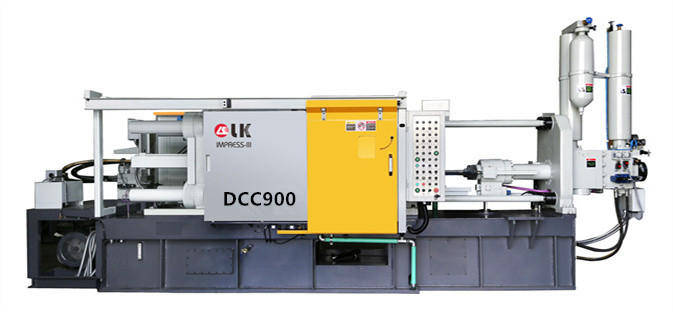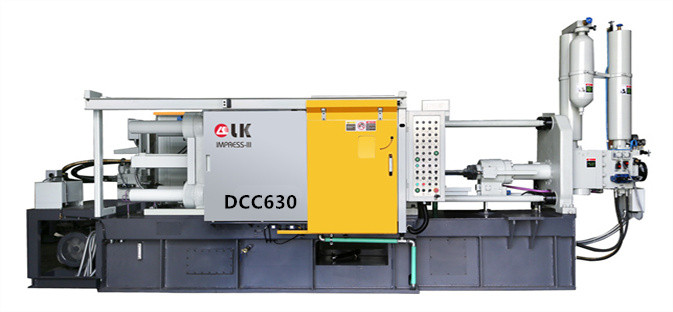How has the structure of your die-casting machine developed?
LK Die Casting Machine / 2024-07-05 16:25:05
Introduction
Die-casting machines are indispensable equipment in the manufacturing industry, and their structural design and performance directly affect product quality and
production efficiency.
This article will introduce in detail the development history of die-casting machine structure, the current technical level and future development trends, to help
readers fully understand the importance of die-casting machines in modern industry.

The development history of die-casting machines
Initial stage Die-casting technology originated in the late 19th century.
The earliest die-casting machines were manually operated, with simple structures and low production efficiency.
Early die-casting machines were mainly used to manufacture parts for low-melting-point metals such as lead and tin.
The emergence of electric die-casting machines In the early 20th century, electric die-casting machines came into being, greatly improving production efficiency.
Die-casting machines in this period began to adopt mechanical drive and electric control and gradually realized semi-automatic production.
The introduction of hydraulic systems In the mid-20th century, hydraulic systems were introduced into die-casting machines, making the die-casting process more
stable and reliable, and the injection pressure and speed were significantly improved.
The application range of hydraulic die-casting machines has been further expanded, and they can handle more types of metal materials.
Application of computer control technology In the late 20th century, with the development of computer technology, die-casting machines began to introduce computer
control systems, realizing full automation and precise control of the production process.
The application of computer control technology makes the die-casting process more flexible, and production efficiency and product quality are significantly improved.
Structure of modern die-casting machines The structure of modern die-casting machines is complex and consists of multiple key components, including injection
system, clamping system, cooling system, and control system.
The functions and technical characteristics of these key components will be introduced in detail below.
Injection system The injection system is the core component of the die-casting machine, and its main function is to inject molten metal into the mold.
Modern injection systems are mainly hydraulically driven and have the characteristics of high precision, high speed, and high pressure.
The key technologies of the injection system include a dual-cylinder injection structure: that improves injection speed and stability, and reduces pores and shrinkage.
Servo control technology: accurately control injection speed and pressure to ensure consistency of product quality. Closed-loop control system: real-time monitoring and adjustment of injection parameters to improve production efficiency and product quality.
Clamping system The main function of the clamping system is to ensure that the mold is tightly closed during the injection process to prevent the molten metal from leaking.
Modern clamping systems are usually hydraulically driven and have the characteristics of high clamping force and high rigidity. The key technologies of the clamping system include a four-column clamping structure: that improves the uniform distribution of clamping force and reduces mold deformation.
Quick clamping technology: shorten the clamping time and improve production efficiency.
Intelligent clamping control: through sensors and control systems, real-time monitoring of clamping force to prevent mold damage.
Cooling system
The main function of the cooling system is to quickly cool the mold and product, and improve production efficiency and product quality.
Modern cooling systems usually use water cooling or oil cooling, which is efficient, stable, and controllable.
The key technologies of the cooling system include Circulating cooling technology: which improves cooling efficiency and uniformity by circulating cooling water or oil. Zoned cooling control: according to different parts of the mold, accurately control the cooling speed and temperature to reduce thermal stress and deformation.
Intelligent cooling management: through the computer control system, real-time monitoring and adjustment of cooling parameters to improve cooling effect.
Control system The control system is the brain of the die-casting machine.
Its main function is to coordinate the work of various components and achieve precise production control.
Modern control systems usually use computer control, which has the characteristics of high precision, high reliability, and high flexibility.
The key technologies of the control system include the human-machine interface (HMI): Which provides a friendly operating interface to facilitate operators to set parameters and monitor. PLC control technology: Through programmable logic controllers, complex production process control and logical operations are realized.
Data acquisition and analysis: Through sensors and data acquisition systems, production data is collected in real-time for analysis and optimization.

Innovative development of die-casting machine structure
Lightweight design With the improvement of environmental protection and energy-saving requirements, the structural design of modern die-casting machines tends to
be lightweight.
Use high-strength and lightweight materials, such as aluminum alloys, carbon fiber composite materials, etc., to reduce the weight of the machine and improve energy efficiency.
Modular design Modular design makes the maintenance and upgrading of die-casting machines more convenient and quick. Through modular structure, each component can be replaced and upgraded independently, reducing downtime and improving production efficiency.
Intelligent technology Intelligent technology is increasingly used in modern die-casting machines.
Through technologies such as the Internet of Things, artificial intelligence, and big data analysis, intelligent monitoring and optimization of the die-casting process can be achieved to improve production efficiency and product quality.
Green manufacturing Green manufacturing is an important direction for the structural design of modern die-casting machines.
Through optimized design and advanced technology, energy consumption and waste emissions can be reduced to achieve environmental protection and sustainable development.
Development trend of die-casting machine structure in the future 4.1 Higher level of automation The die-casting machines of the future will achieve a higher level of automation, further improve production efficiency and product quality through robots and automated production lines, and reduce manual intervention.
Smarter control system The control system of the die-casting machine in the future will be more intelligent, and adaptive control and self-optimization can be achieved through artificial intelligence and machine learning technology, improving the flexibility and reliability of the production process.
More environmentally friendly design The die-casting machines of the future will pay more attention to environmentally friendly design, reduce the impact on the environment, and achieve sustainable development through the use of new energy, energy-saving technology, and green materials.
Higher precision and reliability The die-casting machines of the future will have higher precision and reliability, and through advanced manufacturing technology and precision control systems, improve product quality and consistency to meet the needs of high-end manufacturing.
Conclusion
The development history of die-casting machine structures reflects the progress and changes in modern manufacturing technology.
From the initial manual operation to modern intelligent and automated production, die-casting machines have played an important role in improving production efficiency and product quality.
In the future, with the continuous innovation of technology, the structure of die-casting machines will be more lightweight, modular and intelligent, providing more optimization and development opportunities for small and medium-sized die-casting manufacturers.
Through continuous technological progress and innovation, die-casting machines will contribute more to the sustainable development of the manufacturing industry and green manufacturing.
Contact LK Egypt to learn more info about the die-casting machine
LKAGENT OFFICE DCM
Address: Industry Zone, South of Port Said Kebly, Egypt
https://www.zazdiecasting.com/
Phone: +86 13598704163
Mobile: +20 101 304 3317 +20 150 181 8310
Email: jack@zazmae.com ahmedmahmoud@zazmae.com
#die cast tooling
#trivalent chromate
#rapid prototype casting
#a360 aluminum
#aluminum caster
#aluminum prototype
#ideal 55 slider parts
#density of aluminum kg/mm3
#magnesium sheet metal
#parts of a metal gate
#subcontracting of screw machining for the luxury sector
#wall aluminum
#die casting tooling
#tooling for die casting
#density of aluminium in kg mm3
#clear chromate
#es casting metals
#gating material
#prototype aluminum
#sigma castings
#subcontracting of screw-machining for household appliances
#we squeeze to please machine
#aluminium gravity die casting
#aluminum part
#aluminum rapid prototyping
#nickel casting
#lunger tip for die casting machine
#rapid prototyping aluminium
OTHER CONTENT
-

2024-09-19 14:16:15 LK Cold Chamber Die Casting Machine DCC900 Locking Force: 9000KN Die Height: 400-1000mm Space Between Tie Bars: 930x930mm Shot Weight: 13.5Kg Casting Area Max:2250c㎡
More -

2024-09-19 14:11:06 LK Cold Chamber Die Casting Machine DCC280 Locking Force: 2800KN Die Height: 250-650mm Space Between Tie Bars: 560x560mm Shot Weight: 2.9Kg Casting Area Max:700c㎡
More -

2024-09-19 10:23:07 LK Cold Chamber Die Casting Machine DCC580 Locking Force: 5000KN Die Heigh: 350-850mm Space Between Tie Bars: 760x760mm Shot Weight: 6.9Kg Casting Area Max:1250c㎡
More -

2024-09-19 10:11:20 LK Cold Chamber Die Casting Machine DCC400 Locking Force: 4000KN Die Height: 300-700mm Space Between Tie Bars: 669x669mm Shot Weight: 4.7Kg Casting Area Max:1000c㎡
More

